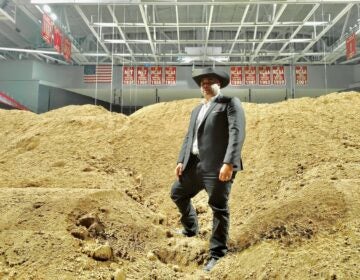Murals set free from prison
Inside the stone ruins of the Eastern State Penitentiary in Philadelphia are the remains of a chaplain’s office. Inside of that are 23 murals painted by an inmate. Inside that is a story of spiritual discovery.
In 1955, while Lester Smith was doing time in Lackawanna County Prison for armed robbery, he had a religious experience: He awoke with a desperate need to paint the crucifixion, and to immediately convert to Catholicism.
When he was later transferred to Eastern State, the chaplain there asked him to paint murals in his office. Smith spent most of his one-year sentence painting his spiritual journey.
“He left behind such a tremendous evidence of that journey on the walls here that we think the public would like to see,” said Eastern State president Sally Elk.
The problem is the public can’t see them–those paintings are hardly there at all. After decades of neglect and ruin, openly exposed to rain and ice, they are as badly decayed as the rest of the prison.
So Eastern State hired conservator Cassie Myers.
“They’re in terrible condition,” said Myers, who is with the conservation company Milner+Carr. “There’s a huge amount of loss. The room had been a ruin for a long time. They’re far from their original appearance. Twenty-five percent loss of the original murals, completely lost. Irretrievably lost.”
Myers is returning to the paintings after a 15-year interval. She was hired in 1996 to stabilize the works with a wax coat. It may have saved them from becoming a dusty pile of paint flakes.
One of the murals–the one portraying Lester Smith himself kneeling before a priest in penitence–was just tattered flaps of paint pulling away from the crumbling concrete, held together only by that wax coating. Myers carefully peeled the mural away from the wall and onto a drum to transport it to her studio for conservation.
Lester Smith died in 2003. His granddaughter, Leslie Johnson, grew up with him but never knew he had ever spent time in prison, or had painted 23 religious murals.
“I would never have thought my grandfather was a prisoner,” said Johnson, who learned of his incarceration only after he died. “He was my grandfather–he was very loving. So it’s hard.”
As a girl, Johnson and her grandfather went to church every Sunday. She knew him as a devout Catholic who was always sketching religious figures. “The only non-religious thing was probably when he was teaching me how to draw dogs.”
The murals show a passionate but untrained hand in the folk-art tradition. Johnson, no longer a practicing Catholic, regards them with reverence: “He’s amazing,” she said.
Conserving the remains of Smith’s opus begins with the building in which they are housed. Most of the $600,000 project funds will go toward making the chaplain’s office weatherproof, and installing a climate-control HVAC system to keep it from freezing.
By the spring of 2012, the murals will be cleaned and touched up, but conservators will not re-create what’s been lost.
WHYY is your source for fact-based, in-depth journalism and information. As a nonprofit organization, we rely on financial support from readers like you. Please give today.




